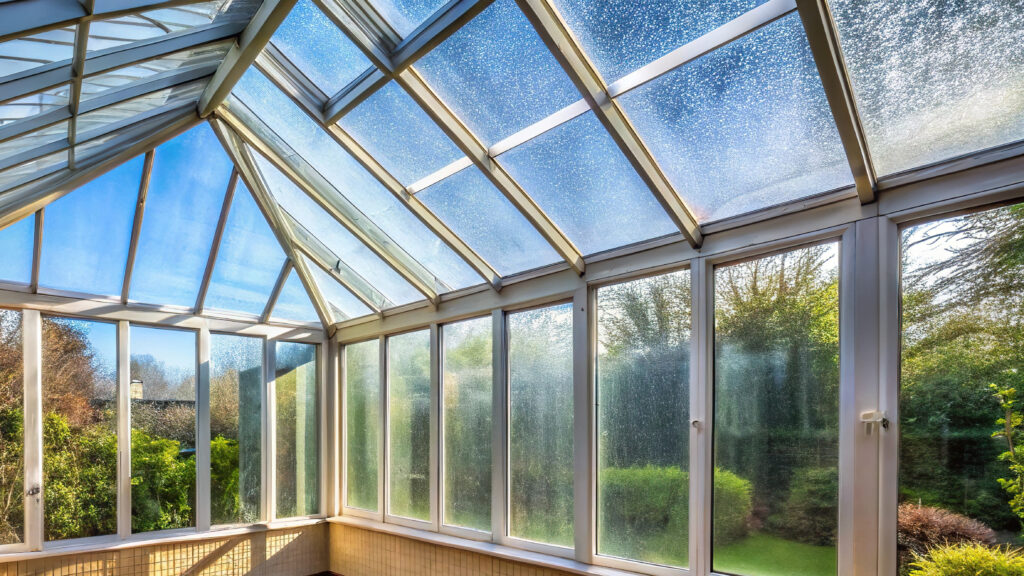Home → Conservatories → Conservatory FAQs → How to stop condensation in a conservatory

Conservatory condensation is regularly on the minds of conservatory owners everywhere. You may find droplets of condensation on your conservatory during the colder months of the year and working out how to stop condensation in a conservatory can be tricky. Condensation appearing is perfectly normal and quite common for conservatories, but it can be annoying. Condensation generally appears on the conservatory glazing and can build up over time.
There are, however, some simple steps you can take to prevent condensation in your conservatory which we have outlined below.
What Causes Condensation In A Conservatory?
The first step on the road to preventing conservatory condensation is working out what causes it. Condensation is caused by the difference in temperature between the inside and outside of your conservatory. When hot air meets the cold surface of a window, the moisture in the air condenses to form droplets, known as condensation.
We tend to heat our conservatories more during the winter months and the outside temperatures are lower, so you’ll often find condensation at this time of year on cold windows. The higher the disparity between the temperature outside and the temperature inside your conservatory, the higher the chance of condensation appearing.
As the level of condensation in your conservatory is affected by the contrast in temperature between the inside and outside, there are three main factors that influence the formation of condensation:
- The temperature of the conservatory windows
- The temperature inside the conservatory
- The moisture levels in the conservatory
Controlling these elements as much as you can is the key to preventing that annoying condensation from building up in your prized conservatory.

Tips For Preventing Condensation In Your Conservatory
So now we know why condensation is forming in your conservatory, let’s consider how to prevent and reduce it. Unfortunately, you can’t raise outside temperatures in winter and sitting in a freezing cold conservatory just to get rid of condensation isn’t exactly ideal. With that in mind, all of the best methods for preventing condensation work by reducing the moisture levels in your conservatory.
There are a number of steps that you can take to bring the humidity down and stop condensation in your conservatory:
Don’t Close Your Conservatory Off From The Rest Of The House
It can be tempting to leave the internal doors to your conservatory shut when it’s cold, but this can be counter intuitive to preventing condensation buildup. Keeping those doors open will allow air to flow around your home freely, and improved air flow is a key weapon in our arsenal against mould and condensation.
The extra ventilation afforded by opening the doors to your conservatory will help to keep moisture levels down in your conservatory and so aid in conservatory condensation prevention.
Avoid Drying Your Clothes In The Conservatory
Conservatories get a lot of sunlight, so logic may suggest that a conservatory is the ideal place to hang your laundry out to dry. Although conservatory spaces do provide great conditions for drying laundry, the moisture from your wet laundry will increase the humidity in the room and exacerbate issues with condensation. Try to avoid hanging up laundry in your conservatory where possible, especially during the winter months where condensation is more likely. If you really have nowhere else to dry your clothes, please use a good de-humidifier while doing so.
Reduce The Number Of Unhelpful House Plants In Your Conservatory
We know that house plants brighten up conservatories and can breathe some life into the space so it is very tempting to have something of a tropical rainforest sitting in your conservatory. Unfortunately, having too many plants can actually increase the amount of condensation in your conservatory because plants release water vapour into the air through tiny holes called stomata. It’s best to keep most house plants out of your conservatory in winter if you want to prevent condensation.
Invest In Plants That Reduce Mould and Condensation In Conservatories
On the flip side, there are actually some really helpful plants that absorb moisture from the air and almost act as natural condensation catchers. As such, buying these plants for your conservatory is a great way to tackle your conservatory condensation problem.
Some houseplants that remove mould and condensation are peace lilies, reed palms and Boston ferns, so adding some of these to your conservatory decor is a good idea.
Buy An Air Dehumidifier For Your Conservatory
If you’ve already tried to increase the ventilation in your conservatory and still have problems with condensation, then you might want to purchase a conservatory dehumidifier. These handy appliances are relatively inexpensive and highly effective at reducing moisture levels in the air – a key step to preventing condensation in a conservatory.
Dehumidifiers work by drawing in air, extracting all of the moisture from that air and collecting the water, ready to be poured away. As we have noted before, reducing humidity levels and excess moisture will ultimately help to stop conservatory condensation, so a simple air humidifier is an essential purchase.
Leave Your Windows In The Night Vent Position
If your windows have multi-point locking functionality, leave your windows in the night vent position – partially open, but locked. This will increase the exchange of air between the inside and outside, helping to balance out the difference in temperature. This additional air circulation and good ventilation will also reduce the humidity levels inside your conservatory and decrease buildup on condensation.
Although the window is locked in this position, it is slightly less secure than being fully locked, so remember to close and lock your windows overnight.
Use Condensation Catchers
Condensation catchers or moisture absorbers do exactly what they say on the tin. These simple but effective products can be placed on your conservatory’s cold window sills and work similar to an electric dehumidifier by drawing out and absorbing moisture from the air, preventing excess moisture. Condensation catchers are inexpensive and can be found in many shops, so adding these to your array of condensation prevention tactics is a no-brainer.
Improve Ventilation With Fans
Fans are an easy way to increase the air flow in and around your conservatory, improving ventilation and helping to reduce conservatory condensation. Ceiling fans are a popular choice for conservatories with little ventilation, not just for helping with condensation issues but also in the warmer months as a way to cool down the space. You could also consider a conservatory extractor fan, which will draw the warm air from your conservatory and disperse it outside, again helping us prevent condensation.
Use Conservatory Roof Vents
If your conservatory is fitted with roof vents, make sure you use these where appropriate. A conservatory roof vent can be either manual or electric and will help with air ventilation, which allows excess air to escape from your conservatory and reduce moisture build up. If you’re considering buying a conservatory or having yours refurbished, it’s a good idea to include roof vents in the plan.

How To Stop Condensation In Your Conservatory: In Summary
Hopefully now you should be fully aware of all the handy ways you can prevent conservatory condensation. To summarise, we recommend:
- Keeping doors to your conservatory open
- Not drying laundry in your conservatory
- Having only moisture absorbing plants in your conservatory
- Buying an air humidifier
- Leaving your windows in the night vent position
- Using condensation catchers
- Adding ceiling or extractor fans
- Making use of conservatory roof vents
Using all our conservatory condensation advice should mean that pesky droplets of condensation on your conservatory windows are a thing of the past and you will have an unrestricted view out of your conservatory all year round.
For more information on preventing condensation on windows specifically, be sure to read our guide available here. To discuss conservatory refurbishment, tiled conservatory roofs or a new conservatory, please get in touch.


